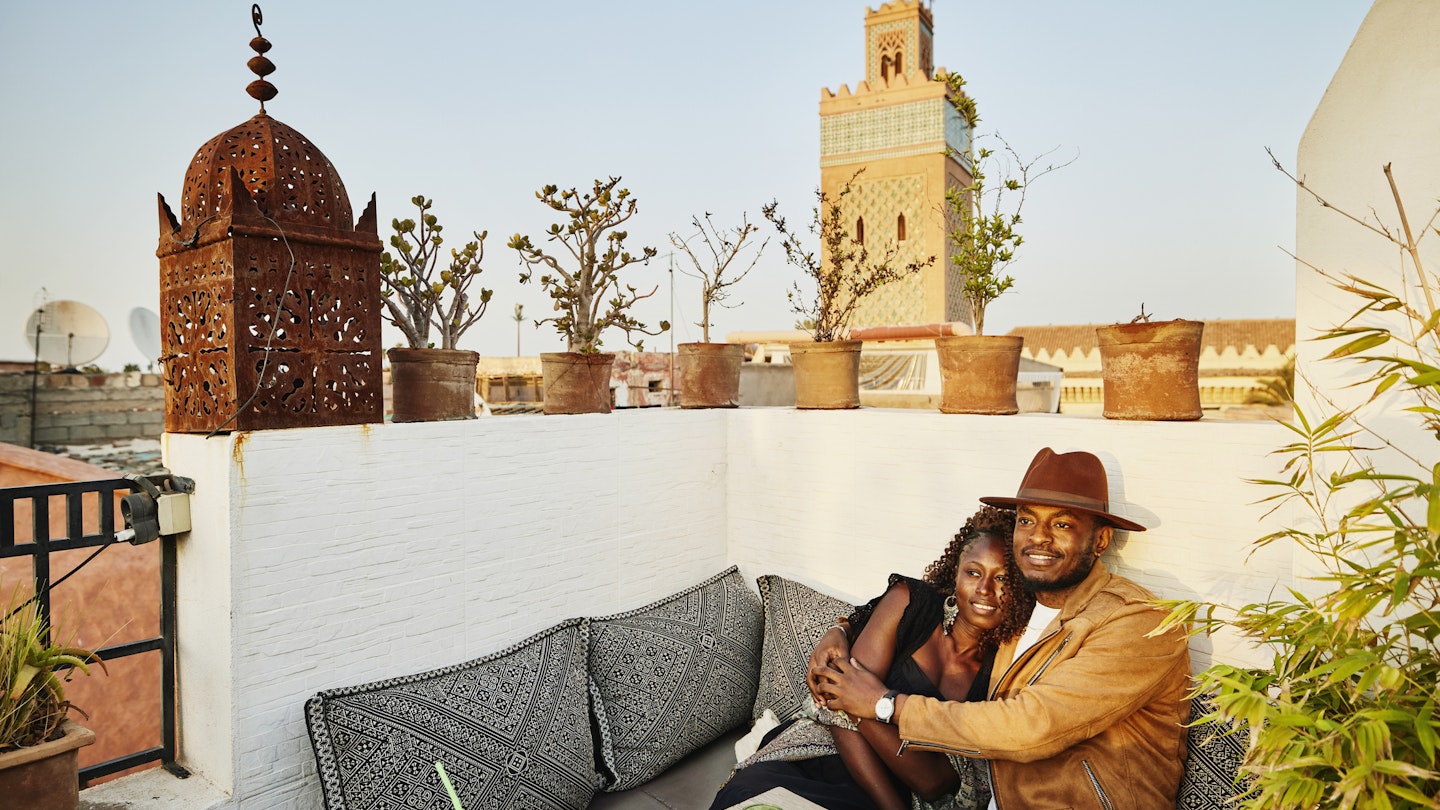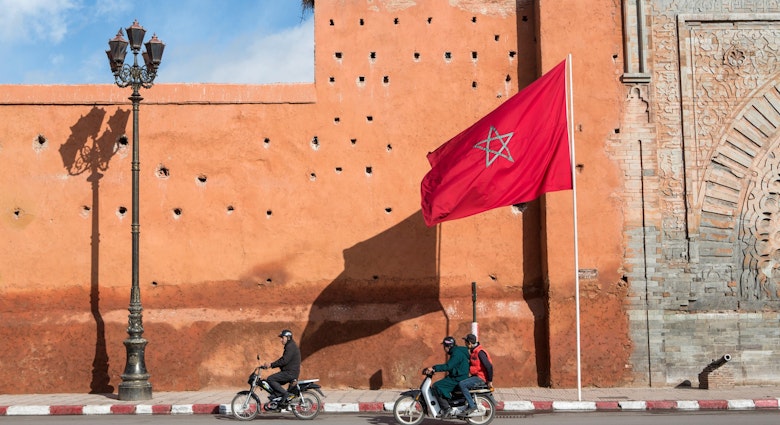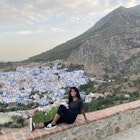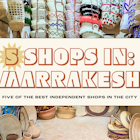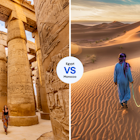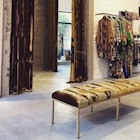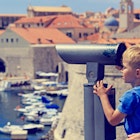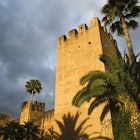Whether you’re a dedicated bargain hunter, passionate about interiors, a spa-o-holic, an obsessive foodie, love exploring places brimming with history and atmosphere, or adore contemporary art, then you’ve come to the right place. Few places on Earth do any of these things quite like Marrakesh.
With so much dynamic creativity on the ground, deciding what to do in the Red City can be overwhelming, especially on a short trip. Here's how to experience the best of Marrakesh.
1. Discover the art of the Moroccan hammam
The hammam and spa at Dar el Bacha, WA Spa, is the hottest newcomer to the city’s burgeoning wellness scene. And what better way to start a trip than to refresh and reset, ready for all those big adventures.
Morocco’s ancient hammam and beauty treatments are a centuries-old much cherished ritual for both cleansing and relaxation. Start with a steam session to open pores and a rub down with black, olive-oil based soap. This is followed by a vigorous exfoliation using a glove called a kessa to slough away dead skin, and an application of ghassoul, a mineral-rich clay, to detoxify and purify the skin before a final shower. Add a soothing massage, an afternoon dip and a snooze by the side of the rooftop pool for the ultimate spa day.
WA offers a range of treatments including a detoxifying hammam that uses pelargonium and grapefruit, a hydrating facial with lavender and argan oil, a 20-minute reflexology foot massage, and a blissful 90 minutes rejuvenating full body massage. Treatments start from 350 MAD.
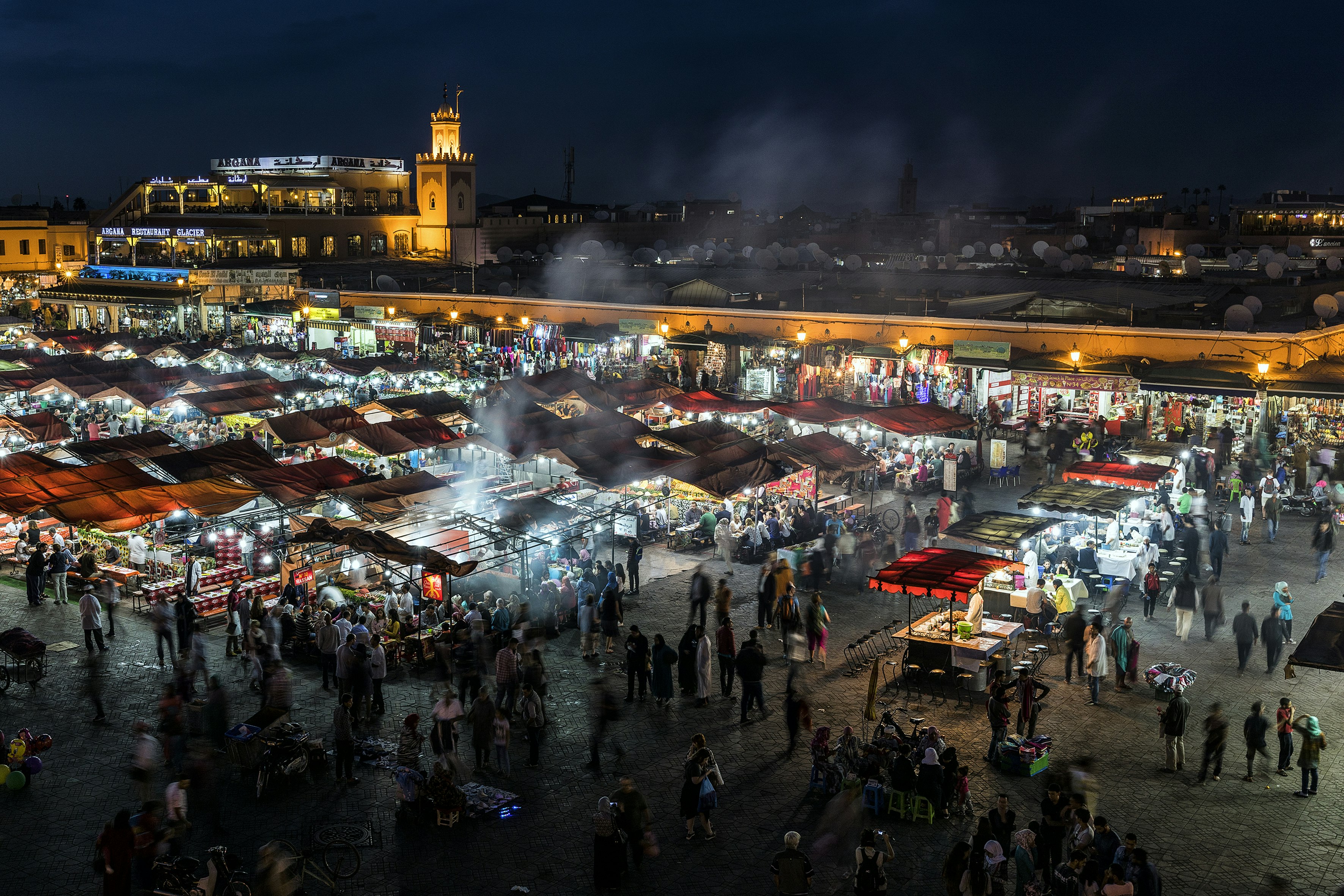
2. Feast on all things Moroccan on the ultimate food tour
Morocco has what's considered to be one of the world's greatest cuisines and rightly so! With Berber, Arabic and Jewish influences, as well as French, Spanish and Portuguese in more recent times, and a smorgasbord of herbs and spices, aromatics and flower waters, ancient techniques and modern innovations, the different flavors and dishes to discover is mind-bending.
For a good general overview of the cuisine head to the Musée D’art Culinaire. But to taste it, let a group of Marrakshi guides with a very deep knowledge of the local food scene show you the way. Moroccan Food Adventures offers a variety of different tours from those aimed at die-hard foodies who want to delve into every detail of the night food market on the Djemaa El Fna, to more nuanced explorations that mix eating with artisan crafts workshops. Prices start from 300 MAD.
Planning tip: If you want to turn a food loving adventure like this into a day trip, take a look at Morocco Food Adventures' Essaouria tour. It’s a long, 12 hour day, but includes comfortable private transportation, guided visits to cultural sights and plenty to eat.
3. Soak up the city’s contemporary art scene
As the home of the annual 1-54 art fair, Marrakesh is now officially the hub of contemporary art in North Africa. And, for a relatively small city, the scope and range of galleries to discover is nothing short of extraordinary.
Ranging from places like Comptoire de Mines Galerie, which shows contemporary Moroccan artists in an old art deco villa in the heart of Gueliz to intimate venues like Galeries Siniya 28 that focuses on the works of the Art Naïf masters of Essaouira while shining a light on emerging and often female artists, there’s a lot to discover. Add landmark projects like African contemporary art museum MACAAL and important residency projects like those at the Montresso Foundation, and it's easy to build an entire weekend around the appreciation of the continent’s art.
Planning tip: The 1-54 art fair in Marrakech takes place February 8–11, 2024 and is spread across two key venues: La Mamounia and new arts space DaDa. This is a time of year when the city really fills up, so book your flights and accommodations well in advance.
4. Dance at sunset at Cafe Clock
Cafe Clock serves as a cultural hub that brings together locals, expats and tourists, offering activities ranging from basic Darija language classes to cooking schools. But it is especially celebrated for evening events that merge storytelling and music concerts leaving an indelible impression of Marrakesh's vibrant cultural spirit.
On Thursdays, as daylight fades, the courtyard and rooftop become a stage for skilled storytellers who transport listeners through time with tales deeply rooted in the country’s ancestral heritage. These narratives, which are simultaneously translated into English, take visitors on a captivating journey into Morocco’s folklore and history. Evenings through the rest of the week fill with the rhythms of sunset concerts, harmonizing traditional and contemporary musical influences from the mystical oud (an instrument from the lute family), to the rather funkier Sahara Sounds, women’s band Houariyat, and Sunday sunset performances of traditional gnawa music.

5. Visit the myriad design studios of Sidi Ghanem
The design studios of Sidi Ghanem epitomize a fusion of traditional Moroccan crafts and contemporary creativity. This artisanal enclave serves as a vibrant hub for artists, designers and craftspeople, each studio showcasing a unique blend of local artisanship and modern aesthetics from pottery and textiles to furniture and fashion.
Visit the studio of LRNCE where many of her painted ceramics and drawn objects come to life. Jajjah (114–116 QI Sidi Ghanem) is Moroccan pop artist Hassan Hajjaj’s new showroom for prints, sardine-can lanterns and cultish tea caddies, as well as being a great place for a cup of tea. Atelier Landon is an art deco lover's dream for lighting and architectural hardware, while the eclectic interiors of the Maison Sarayan restaurant and boutique are a joy to wander round. The Thursday special of a saffron-infused lobster roll, or Saturday brunch party, are well worth making a beeline for.
Planning tip: Getting back from Sidi Ghanem can be a real headache so take the number of your taxi driver and arrange to give them a call about 30 minutes before you want to leave (Google Translate may be useful), or arrange a pick-up time and spot with them in advance.
6. Bargain for treasures at the country’s best flea market
Marrakesh’s Bab el-Khemis, at the main northern gate of the medina, is best known as a taxi pick-up point and one of the country’s finest flea markets. A bustling hub of trade, it occupies several blocks of the neighborhood, roughly distributed into lighting, secondhand furniture, antique doors and windows, with just about everything else you can imagine shoehorned in between.
What Marrakshis know, is that every time one of the city’s iconic hotels, restaurants or homes, comes up for a revamp, much of the stuff that made up their interiors ends up here, so you could be scoring a silver coffee set from La Mamounia, or a chair that once graced the study of one illustrious resident or other.
Planning tip: Thursdays, followed by Sundays, are the best days to visit, and if you make the time to chat with the vendors, you’ll likely come home with all sorts of treasures.

7. Take to the skies on a hot-air balloon ride
When it comes to treating yourself to a once-in-a-lifetime experience, it’s worth the early morning wake-up call for the pure wow factor of Morocco's breathtaking cityscape at dawn. With the majestic peaks of the Atlas Mountains to the south, and the shapeshifting stone dunes of the Agafay Desert to the west, contrasted by the vibrant pinks and reds of Marrakesh's iconic architecture, and a sunrise that paints the entire landscape in streaks of gold and yellow, it’s an unforgettable ride.
Should you be feeling flush, a breakfast hamper with a glass of champagne doesn’t go amiss. There are now several companies offering this experience, but Ciel d’Afrique was the original and remains one of the best, having taken people up, up and away, safely and romantically for over 30 years. Prices start from 2400 MAD.
8. Daydream poolside in an olive grove
Want to know what weekends might look like if you moved to Marrakesh? Beloved by locals and expats alike, Beldi Country Club is just a 10-minute drive from the medina and offers no less than six swimming pools, two of which are open to the public. Black tiled, 40m-long (131ft) and hidden amid fields of olive trees and roses, they bring a whole new meaning to the notion of a pool day.
Fancy a massage while you’re visiting? Book a slot at the spa. Need an activity for the kids? Sign them up for some bread baking or a pottery course. Meanwhile you can have a little stroll around the onsite souk featuring hand-blown glass and pottery, as well as local embroidery, handwoven carpets and bags, hats, jewelry and clothing by local designers. A day pool pass with lunch costs 440 MAD.
Detour: Farasha Farmhouse, a 30-minute drive from Marrakesh, stretches out around a 50m (164ft) pool set within a sea of olive groves. Check out the website for updates on the regular roster of events from intimate rooftop concerts to weekend pool parties.
9. Check out Gueliz’s contemporary food scene
Marrakesh is a food city. From the night market on the Djemaa el Fna hawking everything from grilled lamb brochettes to spicy snail soup, and numerous riad restaurants serving spectacular traditional food, there’s no shortage of good things to eat. But what of the new wave? Head to Gueliz to find out.
Sahbi Sahbi is a women-run restaurant designed by Studio KO that serves the kind of Moroccan dishes you read about, but never seem to see. Plus 61 offers an Australian spin on organically grown market fresh ingredients. Petit Cornichon (27 Rue Moulay Ali) does a magnificent côte de boeuf (rib steak) with the crunchiest frites. Cantine Mouton Noir (115 Rue Mohammed el Beqal) does an excellent weekend brunch featuring treats like truffled eggs. And newcomer Petanque Social Club serves up stellar sharing plates with plentiful vegetarian options in a rambling, jasmine scented garden.
Planning tip: Spring and autumn are the best times of year to visit Marrakech in terms of the weather, but it is very, very busy. Come in the summer and you can snag a bargain accommodation-wise. And the cool days of winter are invariably blessed with the brightest sunshine.

10. Take an early morning stroll around Jardin Majorelle
Designed by French landscape painter Jacques Majorelle in 1922, these botanical gardens boast a wide variety of exotic plants collected from all over the world, interspersed with vibrant cobalt blue and buttercup yellow structures, and tranquil water features. Wandering its maze of paths and terraces is one of the most serene ways to soak up a bit of authentic Marrakshi culture.
The onsite Berber Museum showcases a collection of more than 600 pieces of jewelry, clothing and household objects gathered from all over the country. In the boutique, you’ll find a unique selection of gifts inspired by this heritage, reimagined in bold contemporary cuts and colors. The cafe is a lovely place to stop for coffee or a juice, breakfast or lunch, before heading off on your next adventure.
Planning tip: Buy tickets online in advance to reserve your slot for a visit. As the most-visited site in Morocco it can get crowded, but if you aim for the first slot at 8:30am you should find them fairly tranquil.
11. Watch nightly theater as the sun sets over Djemaa el Fna
As the sun descends over Marrakesh, the Djemaa el Fna transforms into a wildly, exuberant open-air theater of acrobats and storytellers, snakecharmers and henna girls on one side, with a bustling night-food market on the other. Install yourself in one of its numerous cafes – the Cafe Restaurant Argana (traditional) and Cafe Zeitoun (cool) both have fabulous views – and watch the square come to life.
As the sky darkens, the air fills with the aroma of spices and sizzling grills. Stallholders meticulously arrange their wares, flick on their lanterns and start cooking up a feast of traditional dishes from bowls of harira (a hearty soup often including lentils, chickpeas and lamb) and ghoulal (spicy snail soup), to sheep's head, brain and feet, fragrant tangia cooked in the embers of the hammam, smoky merguez sausages and velvety fried aubergines. Prepare for thick crowds, eye-watering smoke and one of the liveliest nights of your trip.
Planning tip: Arrive well in advance if you want to bag a seat for sunset. The square’s evening antics are equally popular with tourists and locals. When deciding where to eat, sit down anywhere that’s busy with locals as that tells you it’s fastidiously fresh.
12. Lose yourself in the opulent Bahia Palace
The Bahia Palace – meaning "brilliance" in Arabic – stands as testament to Morocco’s love of grandeur in aristocratic circles. Commissioned in the late 19th century by Grand Vizier Si Moussa, this architectural gem evolved over decades under the skilled hands of his son and successor, Bou Ahmed, who brought in master craftspeople from Fez to create its legendary interiors.
The sprawling palace complex has a bewitching tapestry of vibrant mosaics, intricately carved wooden ceilings, and elaborate stucco work, set amidst fragrant gardens. Follow labyrinthine passageways into sun-kissed marble courtyards, each space telling the tale of hierarchy and intimacy, power and prestige, and offering a vivid glimpse into the city's rich cultural heritage and the splendor of a bygone era.
Detour: Next door to the palace is the Mellah (Jewish Quarter). Between the 16th and 20th centuries, this was home to one of the biggest Jewish communities in Morocco, with a population of around 30,000 served by 30 synagogues. Two remain – Negidim and Lazama – both of which can be visited. Because it’s relatively untouristy, the souks here are some of the best in the city for stocking up on spices, herbal remedies and treatments for the hammam.
